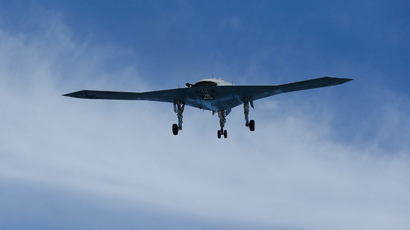FAA announces locations for future drone testing sites

Drones are coming to America – the Federal Aviation Administration announced on Monday the six states chosen to develop test sites for unmanned aerial vehicles.
Alaska, Nevada, New York, North Dakota, Texas and Virginia were chosen by the FAA as the agency moves towards integrating commercial drones into American skies.
The goal is to have drones operated by businesses, farmers and government agencies sharing the same space as commercial airplanes by the year 2015, though it’s possible it may take longer to draft the proper rules and regulations.
"These test sites will give us valuable information about how best to ensure the safe introduction of this advanced technology into our nation's skies," Transportation Secretary Anthony Foxx told the Associated Press.
The test sites, scheduled to be operational through 2017, will be developed at the following locations:
- University of Alaska: Will help develop standards for state monitoring and navigation, as well as safety.
- State of Nevada: Will study standards and requirements for operators. It will also research exactly how air traffic control procedures will change with the introduction of drones into the sky.
- New York’s Griffiss International Airport: Will focus its research on how drones and commercial airplanes will sense and avoid colliding with each other in congested airspace.
- North Dakota Department of Commerce: Will develop “airworthiness” data as well as reliable links that share information between drones and other aircraft.
- Texas A&M University in Corpus Christi: Will develop safety system requirements.
- Virginia Polytechnic Institute and State University: Will test failure mode procedure and other risks should a drone malfunction while in the air.
Although the FAA does not sanction the commercial use of drones just yet, it estimates that close to 8,000 unmanned vehicles could be in the sky within five years of being granted access to American airspace.
"Safety continues to be our first priority as we move forward with integrating unmanned systems into US airspace," FAA Administrator Michael Huerta said in a statement. "We have successfully brought new technology into the nation's aviation system for more than 50 years, and I have no doubt we will do the same with unmanned aircraft."
Studies have estimated that between 70,000 – 100,000 American jobs could be created by a widespread drone industry that generates more than $80 billion in economic activity. Amazon.com CEO Jeff Bezos has already declared his interest in using drones to deliver packages.
Others, however, are less excited about the prospect of drones taking over US skies. The American Civil Liberties Union has spoken out against giving these vehicles greater access to American airspace in the past, saying it would move the country towards "a surveillance society in which our every move is monitored, tracked, recorded and scrutinized by the authorities.”














